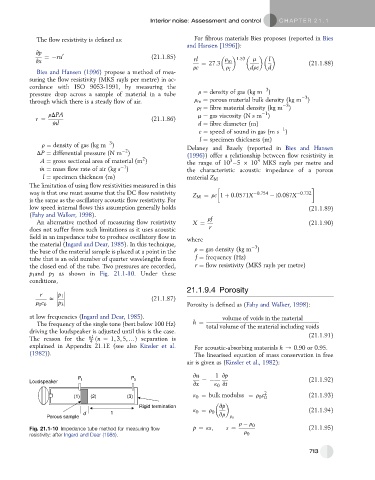Page 702 - Automotive Engineering Powertrain Chassis System and Vehicle Body
P. 702
Interior noise: Assessment and control C HAPTER 21.1
The flow resistivity is defined as: For fibrous materials Bies proposes (reported in Bies
and Hansen [1996]):
vp 0
¼ ru (21.1.85) 1:53
vx rl ¼ 27:3 r m m l (21.1.88)
rc r f drc d
Bies and Hansen (1996) propose a method of mea-
suring the flow resistivity (MKS rayls per metre) in ac-
cordance with ISO 9053-1991, by measuring the 3
pressure drop across a sample of material in a tube r ¼ density of gas (kg m ) 3
through which there is a steady flow of air. r m ¼ porous material bulk density (kg m )
3
r f ¼ fibre material density (kg m )
rDPA m ¼ gas viscosity (N s m )
1
r ¼ (21.1.86)
_ ml d ¼ fibre diameter (m)
1
c ¼ speed of sound in gas (m s )
l ¼ specimen thickness (m)
3
r ¼ density of gas (kg m ) Delaney and Bazely (reported in Bies and Hansen
2
DP ¼ differential pressure (N m ) (1996)) offer a relationship between flow resistivity in
2
A ¼ gross sectional area of material (m ) the range of 10 5 10 MKS rayls per metre and
4
3
1
_ m ¼ mass flow rate of air (kg s ) the characteristic acoustic impedance of a porous
l ¼ specimen thickness (m) material Z M
The limitation of using flow resistivities measured in this
way is that one must assume that the DC flow resistivity 0:754 0:732
Z M ¼ rc 1 þ 0:0571X i0:087X
is the same as the oscillatory acoustic flow resistivity. For
low speed internal flows this assumption generally holds (21.1.89)
(Fahy and Walker, 1998). rf
An alternative method of measuring flow resistivity X ¼ (21.1.90)
does not suffer from such limitations as it uses acoustic r
field in an impedance tube to produce oscillatory flow in where
the material (Ingard and Dear, 1985). In this technique, 3
the base of the material sample is placed at a point in the r ¼ gas density (kg m )
tube that is an odd number of quarter wavelengths from f ¼ frequency (Hz)
the closed end of the tube. Two pressures are recorded, r ¼ flow resistivity (MKS rayls per metre)
p 1 and p 3 as shown in Fig. 21.1-10. Under these
conditions,
21.1.9.4 Porosity
r
p 1
z (21.1.87)
0
r c 0 p 3 Porosity is defined as (Fahy and Walker, 1998):
at low frequencies (Ingard and Dear, 1985). volume of voids in the material
The frequency of the single tone (best below 100 Hz) h ¼ total volume of the material including voids
driving the loudspeaker is adjusted until this is the case.
The reason for the nl ðn ¼ 1; 3; 5; .Þ separation is (21.1.91)
4
explained in Appendix 21.1E (see also Kinsler et al. For acoustic-absorbing materials h / 0.90 or 0.95.
(1982)). The linearised equation of mass conservation in free
air is given as (Kinsler et al., 1982):
vu 1 vp
P P
Loudspeaker 1 3 ¼ (21.1.92)
vx k vt
0
(1) (2) (3) k 0 ¼ bulk modulus ¼ r c 2 (21.1.93)
0 0
Rigid termination vp
0
d 1 k ¼ r 0 vr (21.1.94)
Porous sample r 0
r r 0
Fig. 21.1-10 Impedance tube method for measuring flow p ¼ ks; s ¼ (21.1.95)
resistivity: after Ingard and Dear (1985). r 0
713

